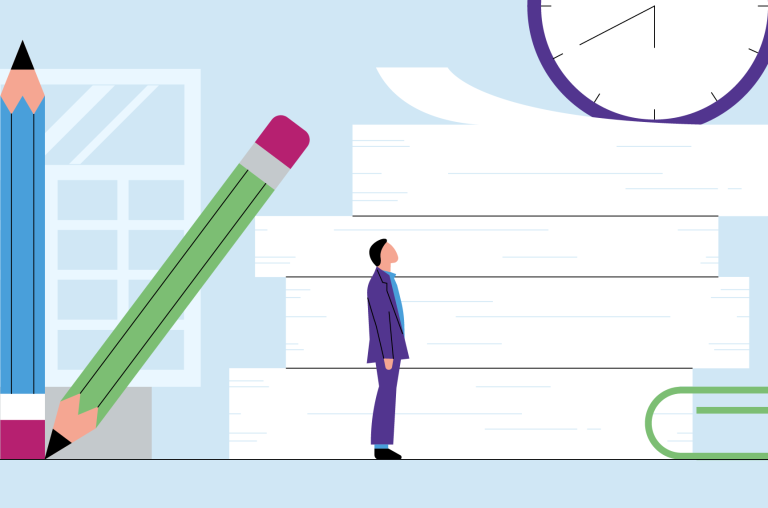Adaptability is the ability to adjust one’s behavior, mindset, and approach in response to changing circumstances while maintaining productivity and effectiveness.
In the workplace, adaptability can mean adjusting to staff changes, navigating a new remote work policy, or working with new employees after a merger or acquisition. In these situations, adaptability means being flexible while maintaining equanimity, so these changes don’t impact the team’s workflow or overall wellness.
The modern workplace demands professionals who can navigate constant changes, from technological shifts to evolving market conditions. This skill extends beyond mere flexibility and encompasses a proactive mindset that welcomes new challenges and opportunities.
Adaptable employees demonstrate this capacity by embracing new technologies, adjusting to different work arrangements, and modifying their communication styles to suit diverse team dynamics. Their approach helps organizations maintain competitiveness and resilience in an increasingly shifting business landscape.
What are workplace adaptability skills?
Adaptability is the ability to manage change in new conditions while staying focused on goals. Adaptability skills can be internal, such as adjusting mindsets and thoughts about specific processes or objectives, and external, which focus more on changing actions and behaviors.
For example, when an organization plans to outsource a department that once operated in-house, an internal adaptation involves adopting a growth mindset and considering ways to improve business outcomes with the new structure. External adaptation is required when a new global team joins an organization by proactively communicating to establish effective systems and workflows.
Under the umbrella of adaptability, leaders can develop a pool of traits and skills to improve workforce agility.
Essential adaptability skills include:
- Empathy
- Respect
- Creativity
- Positivity
- Innovation
- Critical thinking
- Flexibility
- Mindfulness
- Honesty
- Confidence
- Dependability
- Communication
“Research shows that employees who exhibit adaptability have longer tenures and higher satisfaction rates,” says Brian Fink, Senior Talent Acquisition Partner at McAfee. “Adaptability is the single greatest predictor of longevity and success, outranking even technical skills.”
Adaptability examples in the workplace
Since the onset of the pandemic, leaders and talent have become far better at adapting to workplace changes. The global workforce experienced a monumental shift in the work environment, and its effects are still felt today.
Let’s look at some ways the workplace has adapted over the years:
- Adopting remote work. When the pandemic started, businesses around the world adopted remote work policies to keep people safe. After reaping the benefits of remote work, many companies maintained remote or hybrid work arrangements to continue enjoying the benefits that a flexible work policy gave to both leaders and talent.
- Adopting asynchronous work. With remote work policies in place, businesses subsequently adopted asynchronous work. This policy gives talent the flexibility to choose a work schedule that best suits their life and time zone.
- Adopting new technologies. Remote, asynchronous work ushered in the widespread adoption of web-based communication and productivity technologies, such as Zoom, Slack, and Asana. These technologies enabled distributed teams to collaborate and work efficiently, regardless of their location.
- Adopting a global workforce. Remote, asynchronous work policies and new technologies helped businesses reap the benefits of hiring and managing a distributed global workforce. Engaging talent beyond borders allows hiring teams to find the right candidate with the right skills while maximizing their hiring budget.
There’s ample data that underscores the power of workplace adaptability. Research shows that people proficient in adaptability are 24% more likely to be employed. Similarly, a related survey from McKinsey revealed that companies investing in adaptability training significantly improved employee engagement (46%) and work effectiveness (21%).
Why is adaptability important in the workplace?
The ability to adapt can help leaders better manage their teams and cultivate a positive environment for employees. Adaptability soft skills focus on empathy, communication, and mindfulness, all of which can make for better leaders.
Being open to and accepting change can help improve a company’s culture and growth, even during economic uncertainty. Workflow fluctuations are common in the business world, and the ability to lead with empathy and thrive amidst these changes instills confidence and trust in a team.
The importance of adaptability couldn’t be more emphasized among leaders of globally distributed teams. “The interconnectedness of the world’s economies, cultures, and populations requires adaptability to understand and engage with diverse perspectives and customs,” states Frank Choy, Management Consultant & CFO at Capstone Consulting. “Being adaptable in this context promotes better communication, understanding, collaboration, and innovation across borders,” he adds.
Companies like Slack foster adaptability by encouraging teams to experiment with new features and praising efforts even when initial attempts fail. This approach not only accelerates innovation but also creates a psychologically safe environment where employees feel empowered to take calculated risks and respond quickly to changing market demands.
Why adaptability is a critical leadership skill
Leadership requires flexibility amid change—a key tenet of adaptability. Those who adapt are inherently confident and resourceful, which are essential traits for managers and business leaders.
Adaptability also shows a sense of optimism in the face of adversity. When a leader shows dependability and can communicate their plans for the future, teams look up to and likely adopt the leader’s creative and innovative energy.
For example, a leader transitioning their team from fully remote to hybrid work invites employees to share concerns and find flexible arrangements that satisfy everyone.
Ultimately, an adaptable leader is one who fully adopts a growth mindset when changes arise, and that mindset motivates their teams to join them.
5 tips for improving adaptability at work
Adaptability is now a requirement for leadership roles: A Harvard Business School survey found that 71% of global executives rank adaptability as the most important leadership skill. Here’s how professionals can foster adaptability in the workplace.
1. Promote psychological safety in the workplace
Leaders should foster a work environment that makes employees feel safe to publicly or privately raise concerns. Whether it be about a conflict, disagreement, new idea, or accomplishment, employees should have an open channel of communication at work and feel safe to use it without hesitation.
When leaders promote psychological safety, they encourage employees to speak openly, suggest ideas, resolve problems, and innovate without fear of rebuke.
Example: A leader announces that the company’s work policy is changing from fully remote to hybrid but acknowledges that this may be challenging for some employees. The leader invites staff to speak with them privately to discuss other arrangements that support employees’ needs.
Adaptability soft skills: Empathy, communication, mindfulness
2. Practice truthfulness and transparency
Leaders can practice transparency by proactively discussing any business or industry developments that impact their employees. Rather than shielding staff from news, leaders should instead respect their team’s desire to know, regardless of whether the news is good or bad.
Improving trust between employees and leaders helps employees feel more open and accepting of changes. Employees in the know are likely to adapt more quickly than those who don’t understand or trust their leader’s decisions.
Example: A company decides to merge its business with another to improve its financial outlook. Its leaders communicate this to staff as soon as the decision is made, provide data and context behind the decision, detail if and how it will impact their jobs and compensation, and provide a timeline of what to expect before, during, and after the merger.
Adaptability soft skills: Respect, communication, honesty
3. Praise effort in addition to accomplishments
Innovation is an exciting part of any business, but it’s up to the leaders to encourage out-of-the-box thinking within their teams.
Praising employees for showing genuine effort when they try new things to further the business’ success—even if it fails—is crucial for encouraging innovation. Leaders should support failure as a learning opportunity and encourage their employees to try again rather than reprimand them for not succeeding the first time.
Praising effort is part of a growth mindset for both leaders and employees. When leaders praise effort, they instill confidence in the employee’s ability to think creatively. Employees are more likely to try again with continued enthusiasm and velocity, making them far more likely to produce superior results.
Example: An employee suggests a new software tool that would expedite production but fails to provide a cost-benefit analysis. Rather than dismissing the idea, their manager praises them for their innovative thinking and asks them to put together a cost-benefit analysis to justify purchasing the new software. This language encourages the employee to learn from their mistake and keep thinking outside the box.
Adaptability soft skills: Empathy, respect, innovation
4. Prioritize diversity, equity, and inclusion
Promoting diversity, equity, and inclusion (DEI) in the workplace is important for empowering creativity and innovation. A successful DEI program not only honors all individuals with support and respect but also spurs adaptability in the workplace.
A Harvard Business Review study found that companies that adopt DEI correlate with better “change power,” which is linked not only to the company’s overall performance but also to leadership roles and employee engagement.
Companies that commit to building a diverse, inclusive, and equitable workforce create a culture status quo of innovation and adaptability.
Example: A company leader implements a mentorship program to ensure all employees have access to improving their career path.
Adaptability soft skills: Innovation, empathy, critical thinking
5. Look for adaptability skills in new hires
Leaders form powerful teams when they hire talent with adaptability skills. Therefore, when interviewing new employees, hiring managers should ask questions to determine whether the interviewee exhibits adaptability skills. In other words, they should aim to measure the interviewee’s adversity quotient (AQ).
An AQ gauges how well a person can navigate challenges. Hiring managers should look for signs of resilience in new hires—that they can be flexible, persistent, and resourceful in the face of change.
To determine a person’s AQ, look for the following traits:
- Creative problem-solver
- Takes responsibility for mistakes
- Confident decision-maker
- Open to feedback
- Active learner
Example: In an interview, a hiring manager asks the following question: “Tell me about a time when you made an error at work and how you handled it.”
Adaptability soft skills: Honesty, flexibility, communication
Final thoughts on adaptability in the workplace
Adaptability is a leader’s superpower and a critical skill in today’s ever-changing economic climate. By embracing change and adopting a growth mindset, leaders and managers can spur innovation and develop a powerful team of critical thinkers.
Velocity Global supports adaptability in the workplace by offering scalable global workforce management solutions. Whether your business is adapting to remote work, global hiring, or expansion into new markets, Velocity Global simplifies every step of the process.
Contact Velocity Global today to learn more about our global workforce management solutions.



